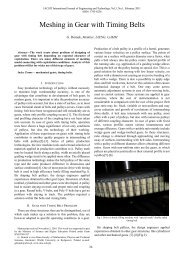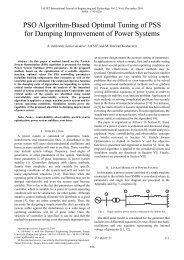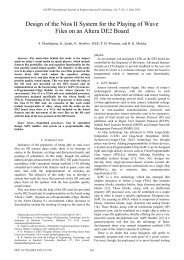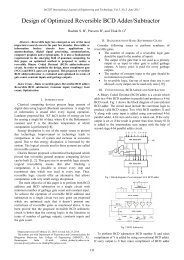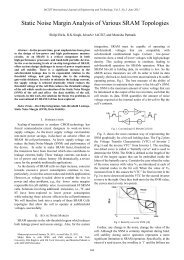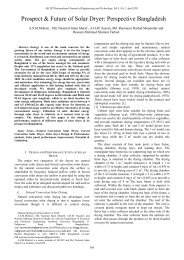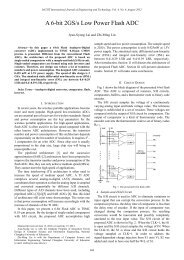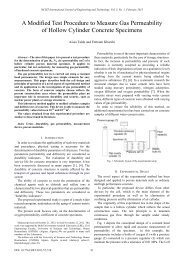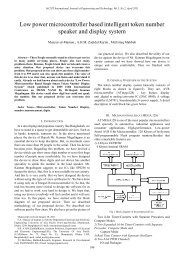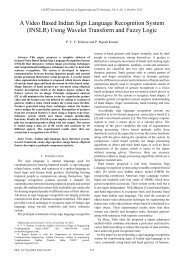The Assessment of Applications for Extension of Time Claims ... - IJET
The Assessment of Applications for Extension of Time Claims ... - IJET
The Assessment of Applications for Extension of Time Claims ... - IJET
You also want an ePaper? Increase the reach of your titles
YUMPU automatically turns print PDFs into web optimized ePapers that Google loves.
IACSIT International Journal <strong>of</strong> Engineering and Technology, Vol. 4, No. 4, August 2012entitlement.Thus, it is important <strong>for</strong> a contractor, particularly whenfacing delays which incurred by the client, in determining hiseligibility in EOT and entitlement <strong>of</strong> suitable EOT in hiscontractual finish-date. Otherwise the contractor will findhimself subject to Liquidated Damages (LAD) <strong>for</strong> reasonswithin the client’s control, but not within his own control.<strong>The</strong>re<strong>for</strong>e EOT claims do happen, and they are <strong>of</strong>ten verydifficult to prepare, both conceptually and practically [5].Planning techniques are frequently used on a project <strong>for</strong>anticipating the possibility <strong>of</strong> EOT. <strong>The</strong>re are many problemsinherent in it [9]. <strong>The</strong> problems are possibly incurred due tothe inability <strong>of</strong> the techniques in conducting retrospectiveanalysis as well as adoption <strong>of</strong> inappropriate technique.<strong>The</strong>re<strong>for</strong>e, a more scientific approach is needed in evaluatingthe EOT in a reasonable model. It can help in avoidingunnecessary dispute or breach contract, cause by the doubtfulin the process <strong>of</strong> claiming extension <strong>of</strong> time.Furthermore, in Malaysia, local practice is doubtful in theprocess <strong>of</strong> claiming and assessing the extension <strong>of</strong> time.<strong>The</strong>re is no standardized procedure or protocol <strong>for</strong> bothcontractors and clients. <strong>The</strong>re<strong>for</strong>e, it is essential to reveal thelocal practice on EOT be<strong>for</strong>e any recommendation <strong>of</strong>methods to reduce EOT claim.<strong>The</strong> objective <strong>of</strong> this study is to identify the major reasons<strong>of</strong> applying EOT in construction project, to review andidentify the most preferred technique used to substantiate andevaluate the EOT, and to identify the alternatives solutionbeside granted EOT.III. EOT EVALUATION TECHNIQUESHowever, subcontractor related problems are still quotedas one <strong>of</strong> the main risk <strong>of</strong> construction project globally [9,17-23]. <strong>The</strong> same applies to Malaysia, problems withsubcontractors have been identified as one <strong>of</strong> the importantcauses contributing to delays in Malaysian constructionindustry. Subcontractor was quoted as one <strong>of</strong> the commoncauses <strong>of</strong> construction delays in Malaysian constructionindustry [24-25].Several techniques are used to evaluate EOT application,namely ‘Global Impact Technique’, ‘Net Impact Technique’,‘But For Technique’, ‘<strong>Time</strong> Impact Technique’ ‘SnapshotTechnique’, and ‘Adjusted As-Built CPM Technique’.Below are the summary <strong>of</strong> these six commonly usedtechniques [5,7]:A. Global Impact TechniqueAll the delays are plotted on a summary bar chart. Totaldelay <strong>of</strong> project is assumed to be the total durations <strong>of</strong> allindividual activities delayed without making allowance <strong>for</strong>concurrent delays in parallel activities.B. Net Impact TechniqueMeasures the net effect <strong>of</strong> all delays including concurrentdelays. It is plotted on a bar chart based on the as-builtschedule. However, this method does not use networkprogrammes and hence may misinterpret the real effect <strong>of</strong> adelayed activity on overall completion.C. Adjusted As-Built CPM TechniqueIn projects where Critical Path Method (CPM) <strong>for</strong>mat isused to develop an as-built schedule. Delays caused will beinserted in CPM without distinguishing between differentcauses <strong>of</strong> delay.D. But For TechniqueInserted all delays that happened due to reasons allowableby contract into as-built schedule. Using CPMnetwork-scheduling <strong>for</strong>mat, a new project completion datewill be calculated. Difference between the new schedule andthe as-planned schedule is the result <strong>of</strong> delay. Differentparties’ ‘but <strong>for</strong>’ might generate different adjusted schedule,e.g. <strong>for</strong> contractor, their ‘but <strong>for</strong>’ is caused byowner/consultant; <strong>for</strong> consultant, their ‘but <strong>for</strong>’ might be dueto owner/contractor.E. <strong>Time</strong> Impact TechniqueImpact <strong>of</strong> each delay or delaying event on the schedule isdetermined at the relevant construction stage. A ‘stop actionpicture’ <strong>of</strong> the project would be produced based on theimpacts <strong>of</strong> be<strong>for</strong>e and/or after major delays. An additionalduration required due to the delay will be added in after the‘stop action’. <strong>The</strong> difference between the projectedcompletion dates at these two stages is considered as thedelay to the project that occurred during the period. In otherwords, when something happened, we assume the activitiesare being stopped. <strong>The</strong> following activities can only becontinued after taking into consideration the delaying event.Total delay in the project is the sum <strong>of</strong> all delays occur duringthe execution <strong>of</strong> the project.F. ‘Snapshot Technique’Similar to ‘<strong>Time</strong> Impact Technique’, but this techniquewill consider the relationship between activities. Totalproject duration is divided into a number <strong>of</strong> time periods, orsnapshots. When delay happened, the extra time betweensnapshots will be studied. <strong>The</strong> accuracy <strong>of</strong> this technique isincreased by having more snapshots.All the techniques discussed above were listed in thesurvey questionnaires to obtain the respondents’ feedback onadopting them in substantiation and assessment <strong>of</strong> claim <strong>for</strong>EOT. In order to ensure respondents understanding on theacademic terms used in the questionnaires, short definitionswere provided <strong>for</strong> each technique listed.IV. DATA COLLECTIONA structured questionnaire was used to gather data.Questionnaires were less expensive to gather data from alarge number <strong>of</strong> respondents. Often this is the most feasibleway to reach a large number <strong>of</strong> reviewers to ensure validityand reliability <strong>of</strong> the results. A well designed questionnairealso enables effective data gathering on both the overallper<strong>for</strong>mance <strong>of</strong> the test system as well as in<strong>for</strong>mation onspecific components <strong>of</strong> the system.<strong>The</strong> questions in the questionnaire are designed in arespondent-friendly multiple choices <strong>for</strong>mat with a fewopen-ended questions at the end. <strong>The</strong> use <strong>of</strong> multiple choicesis due to the natures <strong>of</strong> the construction industry itself, most<strong>of</strong> the respondents probably have no or little time to answeropen-ended questions. Open-ended questions howeverenable a better exploration <strong>for</strong> those respondents who wish toshare more. <strong>The</strong> questionnaires were pilot tested by 3447




